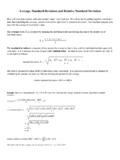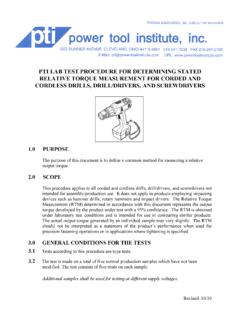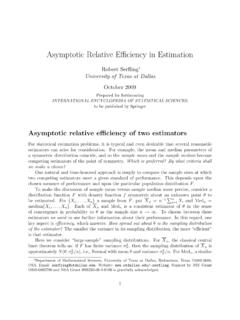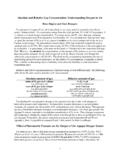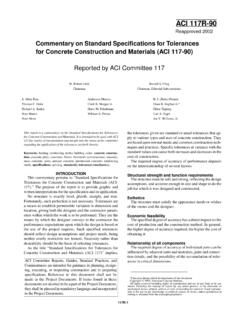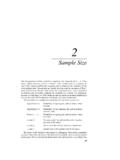Transcription of The Allowable Temperature and Relative Humidity Range for ...
1 Journal of the Society of Archivists, Vol. 17, No. 1, 1996. CONSERVATION FORUM. The Allowable Temperature and Relative Humidity Range for the Safe Use and Storage of Photographic Materials MARK H. McCORMICK-GOODHART, Smithsonian Institution, Washington, DC. Introduction Conventional photographic materials typically make use of a gelatin binder in one or more coating layers. Although the final image may be formed by silver particles, organic dyes, or other inorganic components, gelatin has been the material of choice for more than a century to serve as the image binder. Additional gelatin layers are also frequently present. They function, for example, as anti-curl layers or overcoat layers which improve abrasion resistance andlor alter surface texture.
2 T h e gelatin layers are adhered to a common support layer, and substrates made of acetate, polyester, glass, paper, or polyethylene resin coated paper have found widespread usage. T h e physical structure of the majority of twentieth century photographic films and prints can be understood by considering combinations of these basic material components. T h e environmental guidelines for safe use and storage of photographic materials presented in this paper are applicable to and inclusive of these common varieties of films and papers. Temperature and Relative Humidity recommendations for photographic materials should be cited with two purposes in mind- safe storage and safe use.
3 Room Temperature and moderate Humidity ranges are more suited to the requirements of frequent access and comfortable use and display while low Temperature storage is important, indeed necessary in most cases, to meet long-term preservation objectives. Only Temperature and Humidity levels that reasonably guarantee both chemical and physical safety can be allowed, and the materials must not be harmed by cyclical conditions which occur as they move between storage and use. Chemical stability is often determined by accelerated aging tests, and natural aging Correspondence: Mark H. McCormick-Goodhart, Smithsonian Institution, Washington, DC, USA.
4 0037-98 16/96/010007-15 0 1996 Society of Archivists has confirmed how photographic materials degrade over time. T h e physical stability of photographic images has been more difficult to quantify. Anecdotal evidence clearly indicates that wide environmental cycles, notably changes in Relative Humidity , cause physical damage to photographs. T h e damage appears as cracks, flaking, and permanent warpage or curl. Just as chemical stability data indicate an Allowable Range , physical stability must also be ensured by limiting the changes in Temperature and Relative Humidity to an Allowable Range . A threshold under which minimal physical damage to museum objects will occur has previously been suggested but not Cautious experts have therefore advised against repetitive Temperature and Relative Humidity cycles of any magnitude.
5 Most photographic storage specifications have likewise been established with very tight tolerances for environ- mental cycling; modem HVAC systems can be specified to control within ? 1 and ? 2% RH. Unfortunately, specifications with narrow tolerances are difficult to maintain and make the frequency of access versus the physical well-being of the collection a problematic issue. One cannot freely move items to and from storage and display without violating tight environmental tolerances unless the storage and user environ- ments are perfectly matched. This is very often not the case, particularly when cool and cold storage climates are used.
6 T h e situation leads to uncertainty for the collection manager. How many times a day, a month, or a year can one violate the Temperature and Humidity tolerances? How many large environmental fluctuations equate to more frequent but smaller fluctuations? Ironically, what if a safe threshold really does exist under which no physical damage occurs in response to changes in Temperature and Relative Humidity ? These questions required new research and a scientific method for their r e s ~ l u t i o n . ~. The yield point as a criterion for physical damage Materials do indeed have a threshold for damage as well as a reversible Range of elasticity.
7 As long as the materials are not subjected to environmental cycles which cause them to exceed their true yield point, the materials behave elastically. T h e materials will expand and contract in response to Temperature and RH fluctuations in a completely reversible manner. N o permanent plastic deformation or fracture occurs. Plastic deformation leads to micro defects such as dislocations and voids which ultimately cause cracks, and delamination of composite layers. Many materials tolerate extensive amounts of plastic deformation before actually breaking. However, very brittle materials have little ability to plastically deform before fracture occurs.
8 Total physical safety for all material components can therefore only be guaranteed when all materials remain elastic and are not taken beyond their yield point. Many tests have been conducted in our laboratory in order to determine the true yield point of a wide variety of cultural materials. T h e yield point may be viewed as the change in length which must be exceeded in order to cause a permanent change in length of the material. T h e yield point therefore defines the limits of expansion or contraction which are fully reversible. T h e test materials have included gelatin, polyester, cellulose, cellulose acetate, cellulose nitrate, hide glues, oil, alkyd and acrylic paints, natural and synthetic varnishes, metals, woods, hair, epoxies, and many others old and new.
9 A surprising result was that the true yield point is very consistent. Materials yield at approximately elongation (or slightly greater if they have experienced strain hardening). By using the conservative value of Storage of Photographic Materials 9. elongation for yield and with knowledge of thermal and Humidity coefficients of expansion, the Temperature and RH changes necessary to reach the yield point can be conservatively estimated. The worst case resulting from environmental changes occurs when a material is fully restrained from movement in a uniaxial direction. Physical restraint occurs by confining materials in frames or other fixtures and also arises when one material is bonded to other materials which possess different coefficients of expansion.
10 The composite layers of a photograph are an excellent example of the latter case. A gelatin emulsion adhered to glass, for example, will try to shrink in response to a decrease in Relative Humidity , but it is prevented from doing so by the glass substrate which remains rigid and unresponsive to the change in Humidity . Thus, restraining a layer so that it is not free to shrink or expand in response to environmental changes induces stresses that are just like mechanically applied s t r e ~ s e s .In ~ other words, stresses caused by changes in Temperature and Relative Humidity have the same effect on an object as mechanical stresses caused by physical handling (eg bending, stretching, etc).


